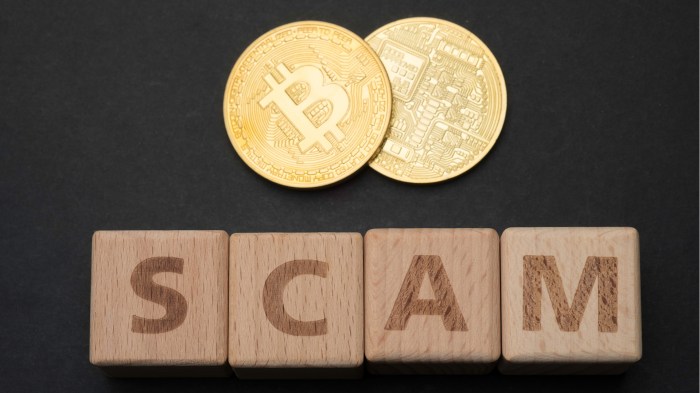Crypto scam: The allure of quick riches in the cryptocurrency world often masks a dark underbelly of sophisticated fraud. This exploration delves into the multifaceted nature of these scams, examining their methods, impact, and the ongoing fight against them. We’ll uncover the psychological tricks used to manipulate victims, explore high-profile examples, and analyze the role of social media in spreading these deceptive schemes.
From understanding the technical vulnerabilities exploited by scammers to learning practical prevention strategies, this comprehensive overview aims to equip readers with the knowledge necessary to navigate the cryptocurrency landscape safely. We will also discuss regulatory responses, the long-term effects on investor confidence, and potential future trends in crypto scams.
Types of Crypto Scams
The cryptocurrency market’s rapid growth has unfortunately attracted a surge in fraudulent activities. Understanding the various types of crypto scams is crucial for protecting yourself from financial loss. These scams often prey on investors’ greed, fear, and lack of knowledge about the complexities of the digital asset space. This section details common crypto scam types, their methodologies, and the psychological vulnerabilities they exploit.
Pump and Dump Schemes
Pump and dump schemes involve artificially inflating the price of a cryptocurrency through coordinated buying (the “pump”), creating a false sense of market demand. Once the price reaches a peak, the perpetrators sell their holdings (the “dump”), causing the price to crash and leaving unsuspecting investors with significant losses. The psychology behind this scam relies on herd mentality and the fear of missing out (FOMO). Individuals see the price rising rapidly and, driven by FOMO, rush to buy in before it’s “too late,” only to find themselves holding worthless assets when the perpetrators sell.
Rug Pulls
Rug pulls involve developers of a cryptocurrency project abruptly abandoning the project and taking investors’ funds. This often happens after a period of marketing and hype, leading investors to believe the project is legitimate and promising. The psychological manipulation lies in creating a sense of trust and excitement around a project, promising high returns and quick profits, before disappearing with the collected funds. This preys on the desire for quick riches and the willingness to trust promises without thorough due diligence.
Phishing Scams
Phishing scams involve fraudulent attempts to obtain sensitive information, such as private keys or login credentials, through deceptive emails, websites, or messages. These scams often mimic legitimate cryptocurrency exchanges or platforms to trick victims into revealing their personal data. The psychology behind phishing relies on social engineering, exploiting human trust and the tendency to overlook subtle inconsistencies in emails or websites. Victims are often tricked into clicking malicious links or providing information under the guise of security updates or account verification.
Ponzi Schemes, Crypto scam
Ponzi schemes promise high returns to investors, paying early investors with funds from new investors. Unlike legitimate investments, these schemes lack any underlying asset or revenue-generating activity. The sustainability relies on a constant influx of new investors. The psychological manipulation centers on the promise of abnormally high and consistent returns, appealing to greed and the desire for easy money. The collapse occurs when the influx of new investors slows down, leaving later investors with significant losses.
Fake ICOs and STOs
Initial Coin Offerings (ICOs) and Security Token Offerings (STOs) are fundraising mechanisms for cryptocurrency projects. However, many fake ICOs and STOs are launched with the sole intention of defrauding investors. These scams often involve creating a misleading whitepaper, website, or marketing materials to attract investors. The psychology at play is the belief in the potential of a new project and the allure of early-stage investment opportunities, often coupled with a lack of understanding of the underlying technology or business model.
| Scam Type | Method | Target Audience | Red Flags |
|---|---|---|---|
| Pump and Dump | Artificially inflating and then crashing a cryptocurrency’s price | Retail investors, inexperienced traders | Unusually high volume, rapid price increases, lack of fundamental value |
| Rug Pull | Developers abandoning a project and taking investors’ funds | All investors, particularly those in early stages | Lack of transparency, anonymous development team, unrealistic promises |
| Phishing | Deceptive emails, websites, or messages to obtain sensitive information | All cryptocurrency users | Suspicious emails, links, or websites; requests for private keys or login credentials |
| Ponzi Scheme | Paying early investors with funds from new investors | Investors seeking high returns | Unusually high and consistent returns, lack of transparency, difficulty withdrawing funds |
| Fake ICO/STO | Misleading marketing materials to attract investors to a non-existent or fraudulent project | Investors seeking early-stage investment opportunities | Unrealistic promises, lack of detailed information, anonymous or inexperienced team |
Prominent Examples of Crypto Scams
The cryptocurrency space, while offering immense potential, has unfortunately attracted a significant number of fraudulent schemes. Understanding these high-profile cases is crucial for investors to learn from past mistakes and protect themselves from future scams. The following examples illustrate the diverse tactics employed by scammers and the devastating consequences for victims.
OneCoin
OneCoin, operating from 2014 to 2017, is considered one of the largest cryptocurrency scams in history. Its founder, Ruja Ignatova, marketed OneCoin as a Bitcoin competitor, promising high returns to investors. However, OneCoin lacked a functioning blockchain and was essentially a Ponzi scheme. Ignatova, along with her network of promoters, used aggressive recruitment tactics and misleading marketing materials to attract investors globally. The total losses suffered by victims are estimated to be in the billions of dollars, with millions of individuals affected across numerous countries. The scam’s strategy relied heavily on multi-level marketing (MLM) principles, where existing investors recruited new ones, earning commissions on their investments. Ignatova remains a fugitive, currently on the FBI’s Most Wanted list.
BitConnect
BitConnect, active from 2016 to 2018, was a cryptocurrency lending platform that promised incredibly high returns through its “volatility software.” This software was never independently verified and was ultimately revealed to be a fabricated mechanism designed to mask a Ponzi scheme. BitConnect’s deceptive marketing emphasized the potential for rapid wealth accumulation, attracting a large number of investors. The platform’s collapse resulted in significant financial losses for its users, with estimates ranging into the hundreds of millions of dollars. The scammers behind BitConnect leveraged sophisticated marketing campaigns and influencer endorsements to gain credibility and attract investment. The platform’s structure allowed for the early investors to be paid with funds from later investors, a classic Ponzi scheme characteristic.
QuadrigaCX
QuadrigaCX, a Canadian cryptocurrency exchange operating from 2013 to 2019, experienced a dramatic collapse after its founder and CEO, Gerald Cotten, unexpectedly passed away. Cotten’s death allegedly left millions of dollars worth of cryptocurrency inaccessible, as he was the sole person with access to the exchange’s cold storage wallets. Investigations revealed significant irregularities in the exchange’s operations, raising questions about the legitimacy of Cotten’s claims and the potential for fraud. While the exact extent of the losses remains debated, thousands of users lost their cryptocurrency investments, totaling millions of dollars. The strategy employed by Cotten, if indeed fraudulent, involved a lack of transparency and inadequate security measures, potentially allowing for the misappropriation of funds. The death of the founder complicated the investigation and recovery efforts for investors.
The Role of Social Media in Crypto Scams

Social media platforms have become fertile ground for cryptocurrency scams, leveraging their vast reach and user engagement to spread deceptive schemes and defraud unsuspecting individuals. The ease of creating accounts, the speed of information dissemination, and the often-lacking verification processes on many platforms contribute to their effectiveness as tools for malicious actors.
Social media’s inherent trust-building mechanisms are exploited to gain the confidence of potential victims. The interactive nature of these platforms allows scammers to build relationships, posing as financial experts, successful investors, or even members of a supportive community. This creates a sense of camaraderie and trust, making victims more susceptible to their fraudulent offers.
Common Social Media Tactics Used in Crypto Scams
Scammers employ a variety of deceptive tactics on social media to lure victims. These range from seemingly legitimate investment opportunities promising high returns with minimal risk, to fake celebrity endorsements, and pump-and-dump schemes orchestrated through coordinated social media campaigns. Understanding these tactics is crucial in protecting oneself from these fraudulent activities. Sophisticated scams often involve coordinated efforts across multiple platforms, creating a complex web of deception.
Social Media Platform Effectiveness in Crypto Scams
The effectiveness of crypto scams varies across different social media platforms due to factors like user demographics, platform policies, and the level of community moderation. A direct comparison is difficult due to the lack of publicly available, comprehensive data on successful scams across all platforms. However, we can observe general trends.
| Platform | Effectiveness Factors | Examples of Scam Tactics |
|---|---|---|
| Large user base, strong community features, potential for targeted advertising | Fake celebrity endorsements, fraudulent investment groups, phishing links disguised as friend requests. | |
| Rapid information spread, influence of prominent accounts, potential for coordinated pump-and-dump schemes | Fake news, misleading information about cryptocurrencies, coordinated tweets promoting fraudulent projects. | |
| Telegram | Private groups, ease of creating channels, limited platform moderation | Pump-and-dump schemes, investment signals from fake experts, fraudulent ICO promotions. |
| Visually appealing format, influencer marketing, focus on lifestyle and wealth | Fake giveaways, endorsements from fake influencers promoting fraudulent projects, get-rich-quick schemes. |
Regulatory Responses to Crypto Scams
The global regulatory landscape surrounding cryptocurrency scams is a complex and rapidly evolving field. Different jurisdictions adopt varying approaches, reflecting diverse legal frameworks, technological understanding, and political priorities. This patchwork of regulations presents both opportunities and challenges in combating these increasingly sophisticated crimes.
The effectiveness of regulatory responses varies considerably across countries. Some nations have proactively implemented robust legal frameworks and enforcement mechanisms, while others lag behind, leaving a regulatory vacuum that scammers exploit. The effectiveness is further complicated by the borderless nature of cryptocurrency, making international cooperation crucial but often challenging to achieve.
Regulatory Approaches in Different Countries
Several countries have taken different approaches to regulate cryptocurrencies and combat scams. The United States, for example, utilizes a multi-agency approach, with the Securities and Exchange Commission (SEC) focusing on securities-related offerings, the Commodity Futures Trading Commission (CFTC) overseeing derivatives, and the Financial Crimes Enforcement Network (FinCEN) addressing money laundering concerns. This approach, while comprehensive in scope, can sometimes lead to jurisdictional overlaps and inconsistencies. In contrast, the European Union is moving towards a more unified regulatory framework through the Markets in Crypto-Assets (MiCA) regulation, aiming for greater harmonization across member states. Singapore has adopted a more principles-based approach, focusing on licensing and supervision of crypto service providers rather than prescriptive rules for all crypto activities. These diverse approaches highlight the challenges of creating a globally consistent regulatory environment for cryptocurrencies.
Effectiveness of Different Regulatory Approaches
The effectiveness of regulatory approaches is difficult to definitively measure, as it depends on various factors, including the resources dedicated to enforcement, the sophistication of the scams, and the level of international cooperation. However, countries with proactive and well-funded regulatory bodies, coupled with effective international cooperation, tend to show better results in disrupting scam operations and recovering stolen funds. For instance, countries with strong anti-money laundering (AML) and know-your-customer (KYC) regulations have proven more effective in tracing illicit cryptocurrency transactions. Conversely, jurisdictions with weak regulatory frameworks or limited enforcement capabilities often struggle to effectively combat crypto scams. The effectiveness is also influenced by the type of scam; regulatory measures designed to address initial coin offerings (ICOs) might not be as effective against sophisticated rug pulls or social media-driven pump-and-dump schemes.
Proposed Solutions and Improvements to Existing Regulations
Several proposals aim to improve the effectiveness of regulatory responses to crypto scams. These include enhancing international cooperation to facilitate cross-border investigations and asset recovery. Improved information sharing between regulatory bodies and law enforcement agencies is crucial. Furthermore, greater focus on consumer education and awareness is needed to help individuals identify and avoid crypto scams. Technological solutions, such as blockchain analysis tools and advanced fraud detection systems, can play a vital role in identifying and tracking illicit activities. Finally, clearer regulatory definitions and classifications of crypto assets are needed to prevent regulatory arbitrage and ensure consistent application of laws across different jurisdictions. This would also help in streamlining enforcement actions and increasing the efficiency of regulatory bodies.
The Impact of Crypto Scams on Investors
Cryptocurrency scams inflict significant harm on investors, extending far beyond the immediate financial losses. The emotional toll and the erosion of trust in the cryptocurrency market are substantial and long-lasting consequences that ripple through individuals’ lives and the broader financial landscape.
The financial repercussions of falling victim to a crypto scam can be devastating. Victims often lose significant portions of their savings, sometimes their entire life savings. This can lead to immediate financial hardship, impacting their ability to meet basic needs such as housing, food, and healthcare. Beyond the direct loss of funds, victims may also face additional costs associated with attempting to recover their losses, such as legal fees or investigative services. The financial instability caused by these scams can create a domino effect, leading to difficulties in securing loans, obtaining credit, and managing other financial obligations.
Financial and Emotional Consequences of Crypto Scams
The emotional consequences of a crypto scam are equally profound. Victims often experience feelings of betrayal, anger, shame, and helplessness. The sense of violation and loss of control can lead to significant stress, anxiety, and even depression. Many victims struggle with self-blame, questioning their own judgment and financial literacy. This emotional distress can have a lasting impact on their mental health and well-being, potentially requiring professional support to overcome. The experience can severely damage trust not only in the cryptocurrency market but also in other financial institutions and individuals.
Long-Term Effects on Investor Trust and Confidence
The widespread prevalence of crypto scams significantly erodes trust and confidence in the cryptocurrency market as a whole. Potential investors, wary of fraudulent schemes, may become hesitant to participate, hindering the growth and adoption of legitimate cryptocurrencies. The negative publicity surrounding scams can create a climate of fear and uncertainty, discouraging both individual and institutional investment. This lack of trust can stifle innovation and development within the cryptocurrency ecosystem, limiting its overall potential. The long-term impact on investor sentiment can be considerable, potentially affecting market stability and hindering the overall maturation of the cryptocurrency industry.
Resources and Support Systems for Victims of Crypto Scams
Several resources and support systems are available to victims of crypto scams. Law enforcement agencies, such as the FBI and the SEC, investigate and prosecute perpetrators of these crimes. Victims should report scams to the appropriate authorities to aid in investigations and potentially recover some lost funds. Consumer protection agencies can provide guidance and support to navigate the legal and financial complexities of recovering losses. Additionally, several non-profit organizations and advocacy groups offer assistance to victims of financial fraud, providing counseling, legal aid, and resources for financial recovery. These organizations offer crucial support in navigating the emotional and practical challenges associated with being a victim of a crypto scam. Seeking help from these organizations can be a crucial step in recovering from the financial and emotional trauma of a crypto scam.
Technical Aspects of Crypto Scams
Cryptocurrency scams often leverage technical vulnerabilities in the underlying blockchain technology and associated platforms. Understanding these vulnerabilities is crucial to mitigating risk and protecting investors. Scammers exploit weaknesses in smart contracts, exchanges, and other aspects of the crypto ecosystem to execute their fraudulent schemes. The decentralized and transparent nature of blockchain, while offering benefits, also presents unique challenges in identifying and preventing these attacks.
Smart Contract Exploits and Exchange Hacks are two major technical avenues used by scammers.
Smart Contract Exploits
Smart contracts, self-executing contracts with the terms of the agreement between buyer and seller being directly written into lines of code, are designed to automate transactions on the blockchain. However, flaws in their code can be exploited by malicious actors. These flaws can range from simple logic errors to sophisticated vulnerabilities allowing attackers to drain funds, manipulate data, or gain unauthorized control. A common exploit involves reentrancy attacks, where a malicious contract calls back into the original contract multiple times before the original transaction is fully completed, leading to unintended multiple executions and depletion of funds. Another example is the use of overflow/underflow vulnerabilities, where improperly handled arithmetic operations can lead to unexpected results and loss of funds. For example, if a smart contract doesn’t properly handle large numbers, an attacker could trigger an overflow error that results in unintended transfers of assets. These exploits often require sophisticated programming skills to identify and execute, making them particularly dangerous.
Exchange Hacks
Cryptocurrency exchanges, platforms that facilitate the buying, selling, and trading of cryptocurrencies, are frequent targets for hackers. These attacks often involve exploiting vulnerabilities in the exchange’s security systems, such as weak passwords, insufficient encryption, or flaws in the exchange’s code. Once access is gained, attackers can steal user funds, manipulate prices, or disrupt the exchange’s operations. In some cases, hackers use phishing attacks to gain access to user accounts, while others exploit vulnerabilities in the exchange’s software or infrastructure. The high value of cryptocurrencies held on exchanges makes them attractive targets, and the consequences of successful attacks can be devastating for users and the exchange itself. The Mt. Gox hack in 2014, which resulted in the loss of hundreds of thousands of bitcoins, serves as a stark reminder of the potential risks.
Blockchain Technology: Facilitation and Prevention
Blockchain technology is a double-edged sword in the context of crypto scams. Its inherent transparency allows for the tracking of transactions, making it easier to identify and investigate fraudulent activities. However, the immutability of the blockchain also means that once a fraudulent transaction is recorded, it is difficult to reverse. This creates a challenge for law enforcement and regulatory bodies. While the blockchain itself cannot prevent all scams, improved smart contract auditing practices, robust security measures implemented by exchanges, and the development of more sophisticated detection mechanisms can help mitigate the risk. Furthermore, the use of multi-signature wallets and other security protocols can add layers of protection for users. The decentralized nature of the blockchain, while sometimes making it harder to regulate, also makes it more difficult for a single point of failure to compromise the entire system, offering a degree of resilience against large-scale attacks.
Prevention and Mitigation Strategies
Protecting yourself from cryptocurrency scams requires a multi-faceted approach encompassing vigilance, knowledge, and secure practices. Understanding the common tactics employed by scammers and implementing robust security measures are crucial to mitigating the risk of financial loss. This section Artikels practical steps individuals can take to safeguard their digital assets and avoid falling victim to these fraudulent schemes.
Practical Steps to Avoid Crypto Scams
Taking proactive measures significantly reduces the likelihood of encountering crypto scams. These steps focus on building a foundation of informed decision-making and secure practices.
- Thoroughly research any cryptocurrency investment opportunity before committing funds. Verify the legitimacy of projects and individuals through independent sources, avoiding reliance solely on promotional materials.
- Be wary of unsolicited investment advice or promises of guaranteed high returns. Legitimate investment opportunities rarely offer such assurances.
- Never share your private keys, seed phrases, or other sensitive information with anyone. These are essential for accessing your cryptocurrency and should be kept strictly confidential.
- Use strong, unique passwords for all your cryptocurrency accounts and exchanges, and enable two-factor authentication (2FA) wherever possible.
- Only use reputable cryptocurrency exchanges and wallets. Research the security measures employed by platforms before entrusting them with your funds.
- Regularly review your account statements and transaction history for any unauthorized activity. Report suspicious transactions immediately to the relevant authorities and your exchange.
- Educate yourself about common crypto scams, such as phishing, pump-and-dump schemes, and rug pulls. Understanding these tactics helps you identify and avoid them.
- Be skeptical of social media influencers promoting cryptocurrency investments. Their endorsements may be paid or incentivized, and not always reflective of genuine investment advice.
Best Practices for Secure Crypto Storage and Transactions
Secure storage and transaction methods are paramount to preventing crypto theft and fraud. This section details best practices for protecting your digital assets.
- Use hardware wallets for storing significant amounts of cryptocurrency. Hardware wallets offer a high level of security by keeping your private keys offline and protected from online threats.
- Diversify your cryptocurrency holdings across multiple wallets and exchanges. This limits the potential impact of a single security breach.
- Regularly back up your seed phrases and keep them in a safe, secure location. Losing access to your seed phrase means losing access to your cryptocurrency.
- Use strong and unique passwords for all your accounts, and consider using a password manager to securely store and manage them.
- Be cautious when clicking on links or downloading attachments from unknown sources. These may contain malware that can steal your cryptocurrency.
- Verify the authenticity of websites and emails before entering any sensitive information. Look for secure connections (HTTPS) and check for typos or inconsistencies in the domain name.
- Only transact with verified and trusted counterparties. Avoid engaging in transactions with anonymous individuals or platforms with questionable reputations.
Flowchart for Identifying and Avoiding Crypto Scams
The following flowchart Artikels a step-by-step process for evaluating cryptocurrency investment opportunities and identifying potential scams.
[Imagine a flowchart here. The flowchart would begin with a box labeled “Cryptocurrency Investment Opportunity?” A “Yes” branch would lead to a series of decision points: “Is the opportunity too good to be true?”, “Is the source reputable?”, “Is there pressure to invest quickly?”, “Do you understand the risks?”, “Are you being asked for personal information?”. Each “No” answer would lead towards a “Proceed with Caution” box, while each “Yes” would lead towards a “High Risk: Avoid” box. A “No” branch from the initial question would lead to a “No Investment” box.] This visual guide helps individuals systematically assess the risks associated with any cryptocurrency investment. Each step prompts a critical evaluation, reducing the chance of falling prey to deceptive schemes.
The Future of Crypto Scams
The cryptocurrency landscape is constantly evolving, and so are the tactics employed by scammers. As cryptocurrencies become more mainstream and sophisticated, we can expect increasingly complex and deceptive schemes to emerge, targeting both novice and experienced investors. Understanding these emerging trends is crucial for strengthening defenses and mitigating future losses.
The future of crypto scams will likely be characterized by a sophisticated blend of technological advancements and social engineering. Scammers will leverage new technologies to create more believable and difficult-to-detect fraudulent activities. Simultaneously, they will continue to exploit human psychology through social media manipulation and emotional appeals. This convergence of technical prowess and psychological manipulation presents a significant challenge for both individuals and regulatory bodies.
Emerging Trends in Crypto Scams
The increasing adoption of decentralized finance (DeFi) protocols presents fertile ground for new scam types. For example, we can anticipate more sophisticated rug pulls, where developers abandon a project, taking investors’ funds with them. These rug pulls might involve complex smart contracts designed to obfuscate the developer’s actions or utilize flash loans to quickly drain liquidity pools. Furthermore, the rise of non-fungible tokens (NFTs) has created opportunities for scams involving fake projects, manipulated rarity, and wash trading to inflate prices artificially. We can also expect to see a rise in scams leveraging the metaverse and other emerging technologies. For example, fake metaverse land sales or promises of unrealistically high returns from metaverse investments are potential future threats.
Future Vulnerabilities in the Cryptocurrency Ecosystem
One significant vulnerability lies in the decentralized nature of cryptocurrencies. While decentralization offers benefits, it also makes it more difficult to track and prosecute scammers operating across jurisdictions. The anonymity afforded by some cryptocurrencies further complicates investigations. Another vulnerability is the complexity of smart contracts. Sophisticated scams can be embedded within these contracts, making it difficult for even experienced users to detect malicious code. The lack of robust regulatory frameworks in many jurisdictions also creates an environment where scammers can operate with relative impunity. The rapid evolution of crypto technologies also creates a constant cat-and-mouse game, where new vulnerabilities are constantly being discovered and exploited.
Technological Solutions to Combat Future Scams
Technological solutions will play a vital role in combating future crypto scams. Improved blockchain analysis tools can help identify suspicious transactions and track the flow of funds. More sophisticated smart contract auditing techniques can help detect vulnerabilities in the code before they are exploited. The development of decentralized identity solutions could help verify the authenticity of projects and individuals involved in the cryptocurrency ecosystem. Artificial intelligence (AI) can be employed to detect patterns and anomalies in market activity, flagging potentially fraudulent activities. Moreover, the development and implementation of more robust security protocols, such as multi-signature wallets and improved authentication methods, can significantly enhance the security of cryptocurrency transactions. The collaboration between blockchain developers, security experts, and regulatory bodies is crucial to proactively identify and address emerging threats.
Case Study: The OneCoin Scam
The OneCoin scam, a particularly egregious example of a cryptocurrency fraud, serves as a compelling case study to illustrate the mechanics and devastating consequences of such schemes. This multi-billion dollar fraud, orchestrated by Ruja Ignatova and her associates, exemplifies the deceptive tactics employed to lure unsuspecting investors into a seemingly lucrative but ultimately worthless investment.
Timeline of Events
The OneCoin scam unfolded over several years, beginning in 2014 with the launch of OneCoin, purportedly a cryptocurrency rivaling Bitcoin. Ignatova, often referred to as the “Cryptoqueen,” aggressively marketed OneCoin through a multi-level marketing (MLM) scheme, promising exorbitant returns and financial freedom. This period saw rapid recruitment of distributors, fueled by lavish presentations and promises of wealth. As the scheme progressed, increasing concerns arose regarding the lack of transparency and verifiable information about OneCoin’s technology and blockchain. Despite these concerns, the recruitment continued, driven by the MLM structure’s incentives. In 2017, investigations began in various countries, leading to the freezing of assets and arrests of key figures. Ignatova disappeared in 2017 and remains at large, while many of her associates have faced legal repercussions. The aftermath involved numerous lawsuits, investigations, and efforts to recover lost funds, which are ongoing.
Actors Involved
The primary actor was Ruja Ignatova, the mastermind behind the scheme. She played a crucial role in creating the fraudulent narrative surrounding OneCoin and driving its aggressive marketing. Her brother, Konstantin Ignatov, also played a significant role, eventually pleading guilty to charges in the United States. Numerous distributors, recruited through the MLM structure, actively participated in the scam, earning commissions from recruiting new members rather than from any legitimate investment return. Law enforcement agencies across multiple jurisdictions, including the FBI and various European authorities, played a key role in investigating and prosecuting individuals involved in the scheme.
Outcomes
The OneCoin scam resulted in billions of dollars in losses for investors worldwide. Many individuals lost their life savings, while others faced significant financial hardship. Several key figures, including Konstantin Ignatov, were convicted and sentenced to prison. The legal proceedings continue to unfold, with efforts ongoing to recover assets and compensate victims. The lasting impact includes a heightened awareness of cryptocurrency scams and the importance of due diligence before investing. The case serves as a stark warning about the risks associated with unregulated investments and the importance of regulatory oversight.
Key Findings Summary
| Aspect | Finding |
|---|---|
| Scheme Type | Multi-level marketing (MLM) Ponzi scheme |
| Primary Actor | Ruja Ignatova (“Cryptoqueen”) |
| Marketing Strategy | Aggressive, high-pressure sales tactics; promises of high returns |
| Technological Basis | Lack of verifiable blockchain technology; fraudulent claims |
| Financial Losses | Billions of dollars in investor losses |
| Legal Outcomes | Arrests, convictions, ongoing investigations and asset recovery efforts |
Last Recap
The cryptocurrency space, while offering immense potential, remains vulnerable to sophisticated scams. Understanding the diverse tactics employed by fraudsters, the psychological manipulation involved, and the available preventative measures is crucial for protecting oneself and fostering a more secure digital asset environment. By staying informed and adopting responsible practices, we can collectively mitigate the risks associated with crypto scams and promote a more trustworthy ecosystem.
Crypto scams are unfortunately prevalent, preying on unsuspecting investors. Understanding the technical advancements in the crypto space can help mitigate risk; for instance, staying informed about key updates like those detailed in the Ethereum 2.0 Updates is crucial. This knowledge empowers individuals to make more informed decisions and better protect themselves from sophisticated crypto scams.
Crypto scams are unfortunately prevalent, preying on unsuspecting investors. A key strategy to mitigate risk and protect your investment is through careful planning and, crucially, Crypto Portfolio Diversification. Proper diversification helps spread risk across various assets, making your portfolio more resilient to the volatility inherent in the crypto market and reducing your exposure to potential scams.
Crypto scams are unfortunately prevalent, often exploiting unsuspecting investors. Understanding the complexities of the crypto world is crucial to avoid falling victim, and a key aspect to consider is the increasing focus on Interoperability Between Blockchains , as this interconnectedness can both facilitate legitimate transactions and create new avenues for fraudulent activities. Therefore, due diligence and awareness remain vital defenses against crypto scams.





